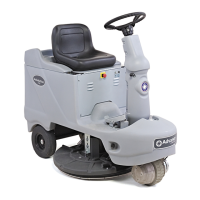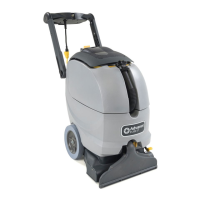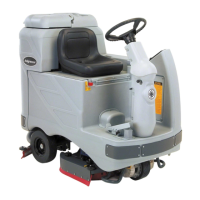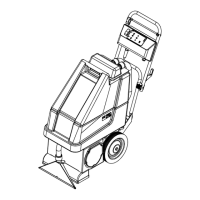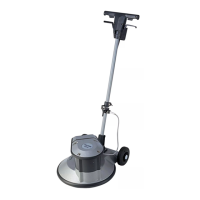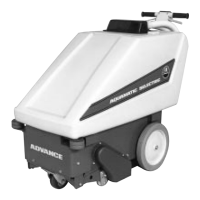40 - FORM NO. 56043088 / Advenger
™
/ BR 600S, 650S, 700S, 800S
RECOVERY SYSTEM
TROUBLESHOOTING GUIDE
If water fl ows around the ends of the squeegee tool, instead of being pulled into the tool, the vacuum system is not working properly. When a
vacuum system performs poorly, it is usually because of one of the following problems:
Vacuum Leak(s) – Air fl owing into the vacuum system past a bad gasket or leaky hose, damaged tank, or a leaky drain valve. A vacuum leak below
the water line will create turbulence in the recovery tank, causing water to enter the vacuum motor.
Restriction(s) – Anything that blocks the fl ow of air through the system. Restrictions may also be caused by built-up debris in the squeegee tool,
vacuum hoses, fl oat cage or wherever the airfl ow is forced to make a sharp turn.
Both leaks and restrictions decrease the quantity of air fl owing through the squeegee tool. The air that does go through the squeegee tool moves
slower, so it has less pick-up power.
Vacuum Electrical Components – The vacuum systems major electrical components are monitored by the main controller to detect any system
function failures (error codes). The system components covered are the vacuum motor and vacuum solenoid. Detected error codes from the
main controller are displayed on the hour meter LED display as they occur. Note: Reference the Main Control Board Troubleshooting Guide in the
Electrical System of this manual for specifi c fault descriptions and service repair actions.
VACUUM / RECOVERY SYSTEM SERVICE MAINTENANCE CHECKLIST
Whenever there is a vacuum problem, it’s best to check over the entire system. Use the checklist below as a guide, to thoroughly check the vacuum
system.
Clean built-up dirt from the inside of the squeegee tool.
Replace the squeegee blades if they are nicked or torn.
Inspect the hose between the squeegee tool and the recovery tank, rinse any built-up dirt from the hose. Replace the hose if it is kinked
or damaged.
Inspect and make sure the gaskets on the recovery tank covers are sealing and not damaged.
Inspect and clean the vacuum motor fl oat cage and vacuum fi lter.
Make sure that the recovery tank drain valve seals airtight.
MAINTENANCE OF VACUUM FILTER AND FLOAT CAGE
See Figure 3. To inspect and clean the vacuum motor foam fi lter just lift open the tethered Vac Duct Cover (A). Remove the fi lter by pulling it out
from the housing opening. Clean the fi lter by vacuum or washing it out in warm water. Note: The fi lter must be completely dry before reinstalling.
To inspect the vacuum shut off fl oat just open the right rear recovery tank cover to access the fl oat cage assembly (back center in recovery tank).
The cage openings must be kept free of any debris that can restrict maximum airfl ow. To keep it clean, wipe off with a rag regularly or remove and
fl ush with water. The cage is a two piece design and can be snapped apart to separate. Note: Another method of accessing the cage fl oat for
servicing is to remove the (6) (B) Screws and remove the vacuum duct housing (C) from the recovery tank top opening.

